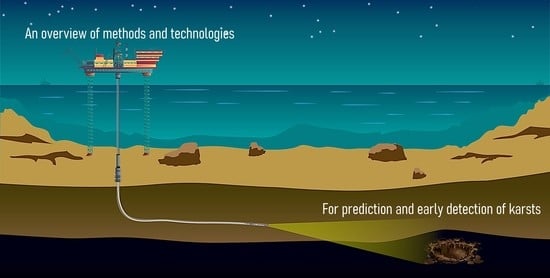Prediction and Early Detection of Karsts—An Overview of Methods and Technologies for Safer Drilling in Carbonates
Abstract
1. Introduction
2. Geological Signs of Karstification
3. Pre-Drill Prediction of Karsts
3.1. Projection of Drilling Risks on Planned Well Path
3.2. Seismic Methods of Karst Detection
4. Real-Time Detection of Karsts
4.1. Drilling Data Method for Karst Detection
4.2. Resistivity Measurements
4.2.1. Ultra-Deep Resistivity Measurements
4.2.2. Resistivity Measurements Ahead of the Bit
4.2.3. Example of Cave Boundary Detection Based on Resistivity Measurements
4.3. Acoustics Measurements
4.3.1. Borehole Acoustic Reflection Survey (BARS)
4.4. Seismic-Based Measurements
4.4.1. Downhole Excitation of Seismic Waves
4.4.2. Directional Sound Waves Generation
4.5. Seismic While Drilling
4.5.1. VSP While Drilling
5. Discussion
6. Conclusions
- Small karsts which are dangerous for drilling are the most challenging objects to detect with pre-drill and while drilling karst detection methods;
- The study of geological drilling or offset wells data solely depends on the quality and coverage of input field data, and thus cannot guarantee an accurate prediction of karsts, leaving the risk of well control issues in carbonates unchanged;
- Any relevant resistivity, acoustics or seismic-based methods can hardly be used for avoiding drilling into karsts or even for the real-time detection of encountering karsts.
Author Contributions
Funding
Institutional Review Board Statement
Informed Consent Statement
Data Availability Statement
Acknowledgments
Conflicts of Interest
Abbreviations
| BHA | Bottom Hole Assembly |
| BARS | Borehole Acoustic Reflected Survey |
| DOI | Depth of Investigation |
| FMI | Formation Micro Imager |
| LCM | Lost Circulation Material |
| LWD | Logging while Drilling |
| MPD | Managed Pressure Drilling |
| MWD | Measurements while Drilling |
| PDC bit | Polycrystalline Diamond Compact Bit |
| PMCD | Pressurized Mud Cap Drilling |
| ROP | Rate of Penetration |
| SGD | Seismic-Guided Drilling |
| SPP | Stand Pipe Pressure |
| S&V | Shocks and Vibrations |
| SWD | Seismic while Drilling |
| TST | True Stratigraphic Thickness |
| VSP | Vertical Seismic Profiling |
| WOB | Weight on Bit |
| SS | Stick and Slip |
References
- Conran, G. Technology Focus: Horizontal and Complex-Trajectory Wells. J. Pet. Technol. 2009, 61, 52. [Google Scholar] [CrossRef]
- Gawor, L.; Jonczy, I. Surface Karst Landforms of the Notranjska region (south-western Slovenia). Geotourism 2014, 37, 55–60. [Google Scholar] [CrossRef][Green Version]
- Mahry, A.; Suryadi, D.; Sufiadi, E.; Hadinata, D.; Wahyudi, Y. Well Control in Carbonate Zone—Total Loss and Kick in Gas Reservoir. In Proceedings of the Offshore Technology Conference, Houston, TX, USA, 2–5 May 2016. [Google Scholar] [CrossRef]
- Hamizan, A.A.; Hasbullah, U.P.; Upadhyay, A.; Buch, M.; Eren, S.; Zahari, M.Z.; Roslan, M.R.; Hajiyeva, M.; Rashid, E.R.; Ishak, S.N.; et al. Mud Cap Drilling (MCD) with Continuous Annular Injection—Offshore Malaysia. In Proceedings of the IADC/SPE Asia Pacific Drilling Technology Conference, Bangkok, Thailand, 25–27 August 2014. [Google Scholar] [CrossRef]
- Sallee, A.; Dick, H.; Sudhakar, V.; Morgan, A.; Payton, S.; Paddock, D. Implementation of PMCD to Explore Carbonate Reservoirs from SemiSubmersible Rigs in Malaysia results in Safe and Economical Drilling Operations. In Proceedings of the SPE/IADC International Drilling Conference and Exhibition, The Hague, The Netherlands, 5–7 March 2019. [Google Scholar] [CrossRef]
- Sallee, A.; Dick, H.; Sudhakar, V.; Morgan, A.; Payton, S.; Paddock, D. Managing Drilling Losses in the Permian Using Airborne Gravity Full Tensor Gradiometry. In Proceedings of the SPE/IADC International Drilling Conference and Exhibition, The Hague, The Netherlands, 5–7 March 2019. [Google Scholar] [CrossRef]
- Kumar, R.; Perumalla, S.; Verma, S.K. Geomechanical Evaluation of Mud Losses and Wellbore Instability in Mumbai High North Field—Implications to Infill Drilling and Reservoir Development. In Proceedings of the SPE Oil and Gas India Conference and Exhibition, Mumbai, India, 28–30 March 2012. [Google Scholar] [CrossRef]
- Giniatullin, R.R.; Kireev, V.V.; Krepostnov, D.D.; Chernokalov, K.A.; Zagrivniy, F.A.; Dobrokhleb, P.Y.; Voitenko, D.N.; Polyarush, A.M. Effective solution for wells drilling in conditions of catastrophic mud losses in fractured reservoirs of the Yurubcheno-Tokhomskoye field. Neft. Khozyaystvo Oil Ind. 2017, 2017, 40–43. [Google Scholar] [CrossRef]
- Murchison, W.J. Lost Circulation for the Man on the Rig; Murchison Drilling Schools: Houston, TX, USA, 2006. [Google Scholar]
- Ivan, C.; Bruton, J.; Bloys, B.; Texaco, C. How can we best manage lost circulation. In Proceedings of the AADE 2003 National Technology Conference “Practical Solutions for Drilling Challenges”, Houston, TX, USA, 1–3 April 2003. [Google Scholar]
- Bahar, A.; Kelkar, M. Journey From Well Logs/Cores to Integrated Geological and Petrophysical Properties Simulation: A Methodology and Application. SPE Reserv. Eval. Eng. 2000, 3, 444–456. [Google Scholar] [CrossRef]
- Heggland, R.; Nygaard, E.; Gallagher, J.W. Techniques and Experiences Using Exploration 3D Seismic Data to Map Drilling Hazards. In Proceedings of the Offshore Technology Conference, Houston, TX, USA, 6–9 May 1996. [Google Scholar] [CrossRef]
- Lewis, S.; Tambe, R.; Dumbre, M.; Ahuja, G.; Sharma, A. Evaluation of LCMs in Cement to Seal Wide Natural Fractures. In Proceedings of the SPE/IATMI Asia Pacific Oil & Gas Conference and Exhibition, Jakarta, Indonesia, 17–19 October 2017. [Google Scholar] [CrossRef]
- Savari, S.; Butcher, J.; Al-Hulail, M. Managing Lost Circulation in Highly Fractured, Vugular Formations: Engineered Usage of High Fluid Loss Squeeze and Reticulated Foam Lost Circulation Materials. In Proceedings of the IADC/SPE International Drilling Conference and Exhibition, Galveston, TX, USA, 3–5 March 2020. [Google Scholar] [CrossRef]
- Houng, N.H.; Zapata, J.F.G.; Fauzi, M.A.A. PMCD Technique Enables Coring and Wireline Logging Operations in Total Lost Circulation. In Proceedings of the IADC/SPE Drilling Conference and Exhibition, Fort Worth, TX, USA, 1–3 March 2016. [Google Scholar] [CrossRef]
- Kyi, K.K.; Han, M.; Lee, S.; Roberts, I.; Maeso, C. Maximising Logging While Drilling Value in Carbonate Wells Drilled in Pressurised Mud Cap Drilling Conditions: Challenges, Solutions, and Advances. In Proceedings of the SPE/IATMI Asia Pacific Oil & Gas Conference and Exhibition, Nusa Dua, Bali, Indonesia, 20–22 October 2015. [Google Scholar] [CrossRef]
- Houng, N.H.; Rubianto, I.; Abuelaish, A.R.; Abdullah, M.A. Successful PMCD Application Significantly Improved Drilling Efficiency on Carbonate Drilling. In Proceedings of the IADC/SPE Asia Pacific Drilling Technology Conference, Singapore, 22–24 August 2016. [Google Scholar] [CrossRef]
- Amanbayev, Y.; Karmanov, K. Successful Implementation of PMCD Technology in Kazakhstan. In Proceedings of the SPE Russian Petroleum Technology Conference, Moscow, Russia, 15–17 October 2018. [Google Scholar] [CrossRef]
- Laouafa, F.; Guo, J.; Quintard, M. Underground Rock Dissolution and Geomechanical Issues. In Proceedings of the 53rd U.S. Rock Mechanics/Geomechanics Symposium, New York, NY, USA, 23–26 June 2019. [Google Scholar]
- Nicod, J. A Little Contribution to the Karst Terminology: Special or Aberrant Cases of Poljes? Acta Carsol. 2003, 32, 29–39. [Google Scholar] [CrossRef]
- Palmer, A. Origin and morphology of limestone caves. Geol. Soc. Am. Bull. 1991, 103, 1–21. [Google Scholar] [CrossRef]
- Veress, M. Karst Types and Their Karstification. J. Earth Sci. 2020, 31, 621–634. [Google Scholar] [CrossRef]
- Andreychouk, V.; Dublyansky, Y.; Ezhov, Y.; Lysenin, G. Karst in the Earth’s Crust: Its Distribution and Principal Types; University of Silesia: Katowice, Poland, 2009; pp. 53–62. [Google Scholar]
- Tangen, G.I.; Smaaskjaer, G.; Bergseth, E.; Clark, A.; Fossli, B.; Claudey, E.; Qiang, Z. Experience from Drilling a Horizontal Well in a Naturally Fractured and Karstified Carbonate Reservoir in the Barents Sea Using a CML MPD System. In Proceedings of the IADC/SPE Managed Pressure Drilling and Underbalanced Operations Conference and Exhibition, Amsterdam, The Netherlands, 9–10 April 2019. [Google Scholar] [CrossRef]
- Bysveen, J.; Fossli, B.; Stenshorne, P.C.; Skärgård, G.; Hollman, L. Planning of an MPD and Controlled Mud Cap Drilling CMCD Operation in the Barents Sea Using the CML Technology. In Proceedings of the IADC/SPE Managed Pressure Drilling & Underbalanced Operations Conference & Exhibition, Rio de Janeiro, Brazil, 28–29 March 2017. [Google Scholar] [CrossRef]
- Claudey, E.; Fossli, B.; Elahifar, B.; Qiang, Z.; Olsen, M.; Mo, J. Experience Using Managed Pressure Cementing Techniques with Riserless Mud Recovery and Controlled Mud Level in the Barents Sea. In Proceedings of the SPE Norway One Day Seminar, Bergen, Norway, 18 April 2018. [Google Scholar] [CrossRef]
- Swan, A. Geostatistical Software Library and User’s Guide, 2nd ed.; Cambridge University Press: New York, NY, USA, 1999. [Google Scholar] [CrossRef]
- Peiling, M.; Dong, L.; Yonglei, L.; Haiting, A.; Xingyin, X.; Qiang, X.; Zujun, W.; Xiangzhou, Z. Seismic Reflection Characteristics of Deeply-Buried, Layered, Karstic Carbonate Reservoir Strata. In SEG International Exposition and Annual Meeting; SEG: Tulsa, OK, USA, 2013. [Google Scholar] [CrossRef]
- Jianxun, Z.; Xukui, F.; Shujun, L.; Shengming, W.; Yan, G. High Resolution 3D Seismic for Mapping of Subsurface Karsting of Carbonate. In CPS/SEG 2004 International Geophysical Conference; World Petroleum Congress (WPC): Houston, TX, USA, 2002. [Google Scholar]
- Xiaowei, W.; Gang, Y.; Yancan, T.; Lei, L.; Shuhai, Q. Analysis of Factors Affecting Carbonate Fracture-Cave Imaging. In SEG International Exposition and Annual Meeting; SEG: Tulsa, OK, USA, 2013. [Google Scholar] [CrossRef]
- Feng, X.; Wang, Y.; Wang, X.; Wang, N.; Gao, G.; Zhu, X. The application of high-resolution 3D seismic acquisition techniques for carbonate reservoir characterization in China. Lead. Edge 2012, 31, 168–179. [Google Scholar] [CrossRef]
- Lin, P.; Peng, S.; Zhao, J.; Cui, X. Diffraction separation and imaging using multichannel singular-spectrum analysis. Geophysics 2020, 85, 1–88. [Google Scholar] [CrossRef]
- Sheriff, R. Factors affecting seismic amplitude. Geophys. Prospect. 1975, 23, 125–138. [Google Scholar] [CrossRef]
- Piwakowski, B.; Watelet, J.; Moreaux, D.; Sbai, K. High resolution seismic prospection of old gypsum mines—Evaluation of detection possibilities. Environ. J. Eng. Geophys. 1996, 2, 149–152. [Google Scholar]
- Wang, N.; Xie, X.B.; Duan, M.C.; Li, D.; Wu, R.S. Improving seismic image resolution in a carbonate fracture cave region: A case study. In SEG Technical Program Expanded Abstracts 2019; SEG: Tulsa, OK, USA, 2019; Chapter 1; pp. 32–36. [Google Scholar] [CrossRef]
- Dhelie, P.E.; Danielsen, V.; Lie, J.E.; Evensen, A.K.; Wright, A.; Salaun, N.; Rivault, J.L.; Siliqi, R.; Grubb, C.; Vinje, V.; et al. Improving seismic imaging in the Barents Sea by source-over-cable acquisition. In SEG Technical Program Expanded Abstracts 2018; SEG: Tulsa, OK, USA, 2018; Chapter 2; pp. 71–75. [Google Scholar] [CrossRef]
- Maksimov, D.; Pavlov, A.; Sangesland, S. Drilling in Karstified Carbonates: Early Risk Detection Technique. In Proceedings of the ASME 2020 39th International Conference on Ocean, Offshore and Arctic Engineering, Fort Lauderdale, FL, USA, 28 June–3 July 2020; Volume 11, pp. 1–10. [Google Scholar]
- Macpherson, J.D.; Mason, J.S.; Kingman, J.E.E. Surface Measurement and Analysis of Drillstring Vibrations While Drilling. In Proceedings of the SPE/IADC Drilling Conference, Amsterdam, The Netherlands, 22–25 February 1993. [Google Scholar] [CrossRef]
- Kirkman, M. Use of Surface Measurement of Drillstring Vibrations to Improve Drilling Performance. In Proceedings of the 14th World Petroleum Congress, Stavanger, Norway, 29 May–1 June 1994. [Google Scholar]
- Wylie, R.; Soukup, I.; Mata, H.; Cuff, S.; Ho, A. The Drilling Optimization Benefits of Direct Drillstring Surface Measurements—Case Studies from Field Operations. In Proceedings of the SPE/IADC Drilling Conference and Exhibition; Society of Petroleum Engineers: London, UK, 2015; pp. 1–28. [Google Scholar] [CrossRef]
- Tanguy, D.R.; Zoeller, W.A. Applications Of Measurements While Drilling. In Proceedings of the SPE Annual Technical Conference and Exhibition, San Antonio, TX, USA, 4–7 October 1981. [Google Scholar] [CrossRef]
- Grosso, D.S.; Raynal, J.C.; Rader, D. Report on MWD Experimental Downhole Sensors. J. Pet. Technol. 1983, 35, 899–904. [Google Scholar] [CrossRef]
- LaGros, F.W., Jr.; Martin, C.A. Applications of Measurements While Drilling (MWD): Development of the East Breaks Field, Offshore Texas. In Proceedings of the SPE/IADC Drilling Conference, New Orleans, LA, USA, 5–8 March 1985. [Google Scholar] [CrossRef]
- Warren, T.W.; Oster, J.H.; Sinor, L.A.; Chen, D.C.K. Shock Sub Performance Tests. In Proceedings of the IADC/SPE Drilling Conference, Dallas, TX, USA, 3–6 March 1998. [Google Scholar] [CrossRef]
- Constable, M.V.; Antonsen, F.; Stalheim, S.O.; Olsen, P.A.; Fjell, O.Z.; Dray, N.; Eikenes, S.; Aarflot, H.; Haldorsen, K.; Digranes, G.; et al. Looking Ahead of the Bit While Drilling: From Vision to Reality. Petrophysics 2016, 57, 426–446. [Google Scholar]
- Brie, A.; Kimball, C.V.; Pabon, J.; Saiki, Y. Shear Slowness Determination From Dipole Measurements. In Proceedings of the SPWLA 38th Annual Logging Symposium, Houston, TX, USA, 15–18 June 1997. [Google Scholar] [CrossRef]
- Hilchie, D.W. Wireline: A History of the Well Logging and Perforating Business in the Oil Fields; D.W. Hilchie: Boulder, CO, USA, 1990; p. 200. [Google Scholar]
- Wu, P.T.; Lovell, J.R.; Clark, B.; Bonner, S.D.; Tabanou, J.R. Dielectric-Independent 2-MHz Propagation Resistivities. In Proceedings of the SPE Annual Technical Conference and Exhibition, Houston, TX, USA, 3–6 October 1999. [Google Scholar] [CrossRef]
- Simms, J.E.; Morgan, F.D. Is There Any Uniqueness And/or Resolution In Resistivity Inversion. In SEG International Exposition and Annual Meeting; SEG: Tulsa, OK, USA, 1989. [Google Scholar] [CrossRef]
- Kim, J.H.; Schon, J.; Towle, G.; Whitman, W.W. An Automatic Inversion Of Normal Resistivity Logs. Log Anal. 1990, 31, 1–10. [Google Scholar]
- Yang, H.J.; Guo, S.S.; Gao, Y.D.; Chen, M.; Wang, C.; Shim, Y.H.; Chang, B.T.; Wang, F.; Li, T. Reduce Drilling Risk in HPHT Gas Field Using Innovative Look-Ahead Technology—A Case Study from South China Sea. In Proceedings of the International Petroleum Technology Conference, Dhahran, Saudi Arabia, 13–15 January 2020. [Google Scholar] [CrossRef]
- Asch, T.; Abraham, J.; Irons, T. A Discussion on Depth of Investigation in Geophysics and AEM Inversion Results. In SEG Technical Program Expanded Abstracts 2015; SEG: Tulsa, OK, USA, 2015; pp. 2072–2076. [Google Scholar] [CrossRef]
- Brian, C.; Stephen, D.B.; Jacques, J.; Martin, L. Well Logging Apparatus Having Toroidal Induction Antenna for Measuring, While Drilling, Resistivity of Earth Formations. U.S. Patent 5,235,285A, 10 August 1993. [Google Scholar]
- Meyer, W.H.; Wu, J.; Macune, D.T.; Harvey, P.R. Near-Bit Propagation Resistivity for Reservoir Navigation. In Proceedings of the SPE Annual Technical Conference and Exhibition, New Orleans, LA, USA, 25–28 September 1994. [Google Scholar] [CrossRef]
- Lindsay, G. An analysis of the at-bit resistivity decision making process. In Proceedings of the International Petroleum Technology Conference, Kuala Lumpur, Malaysia, 3–5 December 2008. [Google Scholar] [CrossRef]
- Rosthal, R.A.; Young, R.A.; Lovell, J.R.; Buffington, L.; Arceneaux, C.L., Jr. Formation Evaluation and Geological Interpretation from the Resistivity-at-the-Bit Tool. In Proceedings of the SPE Annual Technical Conference and Exhibition, Dallas, TX, USA, 22–25 October 1995. [Google Scholar] [CrossRef]
- Biot, M. Theory of Propagation of Elastic Waves in a Fluid Saturated Porous Solid. II. Higher Frequency Range. J. Acoust. Soc. Am. 1956, 28, 179–191. [Google Scholar] [CrossRef]
- Tang, X.; Patterson, D.; Wu, L. Measurement of Formation Permeability Using Stoneley Waves From an Lwd Acoustic Tool. Petrophysics 2009, 51, 2. [Google Scholar]
- Sayers, C.; Nagy, Z.; Adachi, J.; Singh, V.; Tagbor, K.; Hooyman, P. Determination of in situ stress and rock strength using borehole acoustic data. SEG Tech. Program Expand. Abstr. 2009, 28, 3505–3509. [Google Scholar] [CrossRef]
- Morris, C.F.; Little, T.M.; Letton, W., III. A New Sonic Array Tool for Full Waveform Logging. In Proceedings of the SPE Annual Technical Conference and Exhibition, Houston, TX, USA, 16–19 September 1984. [Google Scholar] [CrossRef]
- Maia, W.; Rubio, R.; Junior, F.; Haldorsen, J.; Guerra, R.; Dominguez, C. First Borehole Acoustic Reflection Survey mapping a deepwater turbidite sand. SEG Tech. Program Expand. Abstr. 2006, 25, 87–92. [Google Scholar] [CrossRef]
- Hirabayashi, N.; Martinez, G.A.; Wielemaker, E. Case Studies of Borehole Acoustic Reflection Survey (BARS). In Proceedings of the SPWLA 22nd Formation Evaluation Symposium of Japan, Chiba, Japan, 29–30 September 2016. [Google Scholar]
- Brett, J.F.; Goetz, J.F.; Roberts, A.P. Methods of Employing Vibrational Energy in a Borehole. U.S. Patent 5,309,405A, 3 May 1994. [Google Scholar]
- Bjorn, N.; Paulsson, P. Nondestructive Downhole Seismic Vibrator Source and Processes of Utilizing the Vibrator to Obtain Information about Geologic Formations. U.S. Patent 4,702,343A, 18 March 1986. [Google Scholar]
- Dedole, P.; Grolet, P.; Laurent, J. Device for Generating Sound Pulses Inside a Well, by Percussion. U.S. Patent 4,648,478A, 23 January 1984. [Google Scholar]
- Hardee, H.C. Downhole pereodic seismic sources. Geophys. Prospect. 1983, 31, 57–71. [Google Scholar] [CrossRef]
- Hardee, H.C.; Hills, R.G.; Striker, R.P. Down Hole Periodic Seismic Generator. U.S. Patent 4,805,727A, 28 October 1982. [Google Scholar]
- Hardee, H.C. Fluid Driven Torsional Dipole Seismic Source. U.S. Patent 4,982,811A, 8 August 1989. [Google Scholar]
- Paulsson, B.N.P. Three-component Downhole Seismic Vibrator. In Proceedings of the SEG Annual Meeting, Anaheim, CA, USA, 30 October–3 November 1988. [Google Scholar]
- Chen, S.T.; Eriksen, E.A. Experimental Studio of Downhole Seismic Sources. In Proceedings of the SEG Annual Meeting, Dallas, TX, USA, 29 October–2 November 1989. [Google Scholar]
- Howlett, D.L. Comparison of borehole seismic sources under consistent field conditions. In SEG Technical Program Expanded Abstracts 1991; SEG: Tulsa, OK, USA, 2005; Chapter 2; pp. 18–21. [Google Scholar] [CrossRef]
- Farr, J.B.; Ward, R.W. Seismic Velocity Determination. U.S. Patent 3,881,168A, 11 December 1973. [Google Scholar]
- Klaveness, A. Seismic Well Logging System and Method. U.S. Patent 4,207,619A, 24 February 1975. [Google Scholar]
- Beresford, J.M.; Crowther, P.A. Acoustic Sensor. U.S. Patent 5,798,488A, 30 March 1994. [Google Scholar]
- Leggett, J.V. Measurement-While-Drilling Acoustic System Employing Multiple, Segmented Transmitters and Receivers. U.S. Patent 6,084,826A, 12 January 1995. [Google Scholar]
- Mathiszik, H.; Oppelt, J. Apparatus and Method for Acoustic Position Logging Ahead-of-the-Bit. U.S. Patent 2005/003,491,7A1, 14 August 2003. [Google Scholar]
- Wajid, R. Look Ahead Advance Formation Evaluation Tool. International Publication Patent Number WO2011/080,640,A3, 7 July 2011. [Google Scholar]
- Meehan, R.; Miller, D.; Haldorsen, J.; Kamata, M.; Underhill, B. Rekindling interest in seismic while drilling. Oilfield Rev. 1993, 5, 3–13. [Google Scholar]
- Staron, P.; Gros, P.; Arens, G. Instantaneous Acoustic Logging in a Borehole. Canada Patent 1,255,783A, 25 May 1984. [Google Scholar]
- Ollivier, R.M. Apparatus for the Acquisition of a Seismic Signal Transmitted by a Rotating Drill Bit. U.S. Patent 5,248,857A, 27 April 1990. [Google Scholar]
- Airhart, T.P.; Montgomery, M.G.; Kingman John, E.E.; Livesay, R.B. System for Real-Time Look-Ahead Exploration of Hydrocarbon Wells. WIPO (PCT) Patent WO1993/007,514,A1, 2 October 1992. [Google Scholar]
- Haldorsen, J.; Miller, D.; Walsh, J. Multichannel approach to signature estimation and deconvolution for drill bit imaging. In SEG Technical Program Expanded Abstracts 1992; SEG: Tulsa, OK, USA, 2005; Chapter 1; pp. 181–184. [Google Scholar] [CrossRef]
- James, W.; Rector, I.; Hardage, B.A. Radiation pattern and seismic waves generated by a working roller-cone drill bit. Geophysics 1992, 57, 1319–1333. [Google Scholar] [CrossRef]
- Rector, J.W.; Marion, B.P. The use of drillbit energy as a downhole seismic source. Geophysics 1991, 56, 628–634. [Google Scholar] [CrossRef]
- Naville, C.; Layotte, P.; Pignard, G.; Guesnon, J. Well seismic—Application of the TRAFOR MWD system to drill-bit seismic profiling. In Conference Proceedings, 56th EAEG Meeting, Jun 1994, cp-47-00132; European Association of Geoscientists & Engineers: Houten, The Netherlands, 1994. [Google Scholar] [CrossRef]
- Petronio, L.; Miranda, F.; Poletto, F.; Miandro, R. Seisbit Seismic-while-Drilling Technique Summary of Results Obtained in Onshore Surveys. In Conference Proceedings, 1st EAGE North African/Mediterranean Petroleum & Geosciences Conference & Exhibition, Oct 2003, cp-8-00128; European Association of Geoscientists & Engineers: Houten, The Netherlands, 2003; pp. 18–26. [Google Scholar] [CrossRef]
- Azbek, A. Adaptive beamforming with generalized linear constraints. In SEG Technical Program Expanded Abstracts 2000; SEG: Tulsa, OK, USA, 2005; Chapter 5; pp. 2081–2084. [Google Scholar] [CrossRef]
- Chabot, L.; Henley, D.C.; Brown, R.J.; Bancroft, J.C. Single-well seismic imaging using full waveform sonic data: An update. In SEG Technical Program Expanded Abstracts 2002; SEG: Tulsa, OK, USA, 2005; Chapter 7; pp. 368–371. [Google Scholar] [CrossRef]
- Comelli, P.; Craglietto, A.; Dordolo, G.; Schleifer, A.; Vascotto, G.; Zgauc, F. SEISBIT 3D: The new seismic while drilling data acquisition system. Geophysics 2002, 43, 109–118. [Google Scholar] [CrossRef]
- Poletto, F.; Miranda, F.; Corubolo, P.; Schleifer, A. Drill Bit As a Seismic Source For Near-well Imaging. In SEG International Exposition and Annual Meeting; SEG: Tulsa, OK, USA, 2008. [Google Scholar] [CrossRef]
- Raknes, E.; Moser, T.; Arntsen, B.; Johansen, S.E.; Sangesland, S. Surface Seismic While Drilling—Imaging of Well Bores in Seismic Context. In Proceedings of the 79th EAGE Conference and Exhibition 2017, Paris, France, 12–15 June 2017; pp. 1–5. [Google Scholar] [CrossRef]
- Robbins, C.A.; Linyaev, E.J.; Malloy, R.L.; Young, D.J.; Birchak, J.R.; Minear, J.; Shah, V. Vertical Seismic Profiling in a Drilling Tool. Canada Patent 2,342,765A1, 2 September 1999. [Google Scholar]
- Esmersoy, C.; Underhill, W.; Hawthorn, A. Seismic Measurement While Drilling: Conventional Borehole Seismics on Lwd. In Proceedings of the SPWLA 42nd Annual Logging Symposium, Houston, TX, USA, 17–20 June 2001. [Google Scholar]
- Bertelli, L.; Abramo, F.; Gatti, V. Seismic While Drilling and Geophysical Monitoring in the Southern Apennine Range. In Conference Proceedings, 60th EAGE Conference and Exhibition, Jun 1998, cp-110-00198; European Association of Geoscientists & Engineers: Houten, The Netherlands, 1998. [Google Scholar] [CrossRef]
- Underhill, W.; Esmersoy, C.; Hawthorn, A.; Hashem, M.; Hendrickson, J.; Scheibel, J. Demonstrations of Real-Time Borehole Seismic From an LWD Tool. In Proceedings of the SPE Annual Technical Conference and Exhibition, New Orleans, LA, USA, 30 September–3 October 2001. [Google Scholar] [CrossRef]
- Haldorsen, J.; Krasovec, M.; Raikes, S.; Harrold, T.; Day, D.; Clippard, J. Comparison of Full Waveform SeismicMWD and Conventional VSP Data from the South Caspian Sea. In Conference Proceedings, 64th EAGE Conference & Exhibition, May 2002, cp-5-00592; European Association of Geoscientists & Engineers: Houten, The Netherlands, 2002. [Google Scholar] [CrossRef]
- Adrian, S.B.O.; Alfonso, M.; Leonardo, A.; Rito, G. Minimizing drilling risks for exploration well in deep water using seismic while drilling technology. In Proceedings of the Rio Oil and Gas Expo and Conference, Rio de Janeiro, Brazil, 13–16 September 2010; Volume 8, pp. 115–125. [Google Scholar]
- Peng, C.; Dai, J.; Yang, S. Seismic Guided Drilling: Near Real Time 3D Updating of Subsurface Images and Pore Pressure Model. In Proceedings of the International Petroleum Technology Conference, Beijing, China, 26–28 March 2013. [Google Scholar] [CrossRef]
- Montaron, B.A.; Xue, F.J.; Tian, W.; Han, R.P.R. Cave Geomorphology and its Effects on Oil Recovery Factors in Tarim Karst Reservoirs, West China. In Proceedings of the International Petroleum Technology Conference, Kuala Lumpur, Malaysia, 10–12 December 2014. [Google Scholar] [CrossRef]
- Yang, H.; Pan, W.; Chen, L.; Yang, P. Seismic Description of Karst Topography Furthermore, Caves of Ordovician Carbonate Reservoirs, Lungu Area, Tarim Basin, West China. In SEG Technical Program Expanded Abstracts 2010; SEG: Tulsa, OK, USA, 2010. [Google Scholar]
- Luo, C.; Xue, F.; Deng, X.; Mao, Q.; Yang, P.; Zeng, R. Cave System Analysis—An Effective Approach to Predict Hydrocarbons in Cavernous Carbonate Reservoir. In Proceedings of the International Petroleum Technology Conference, Beijing, China, 26–28 March 2013. [Google Scholar] [CrossRef]
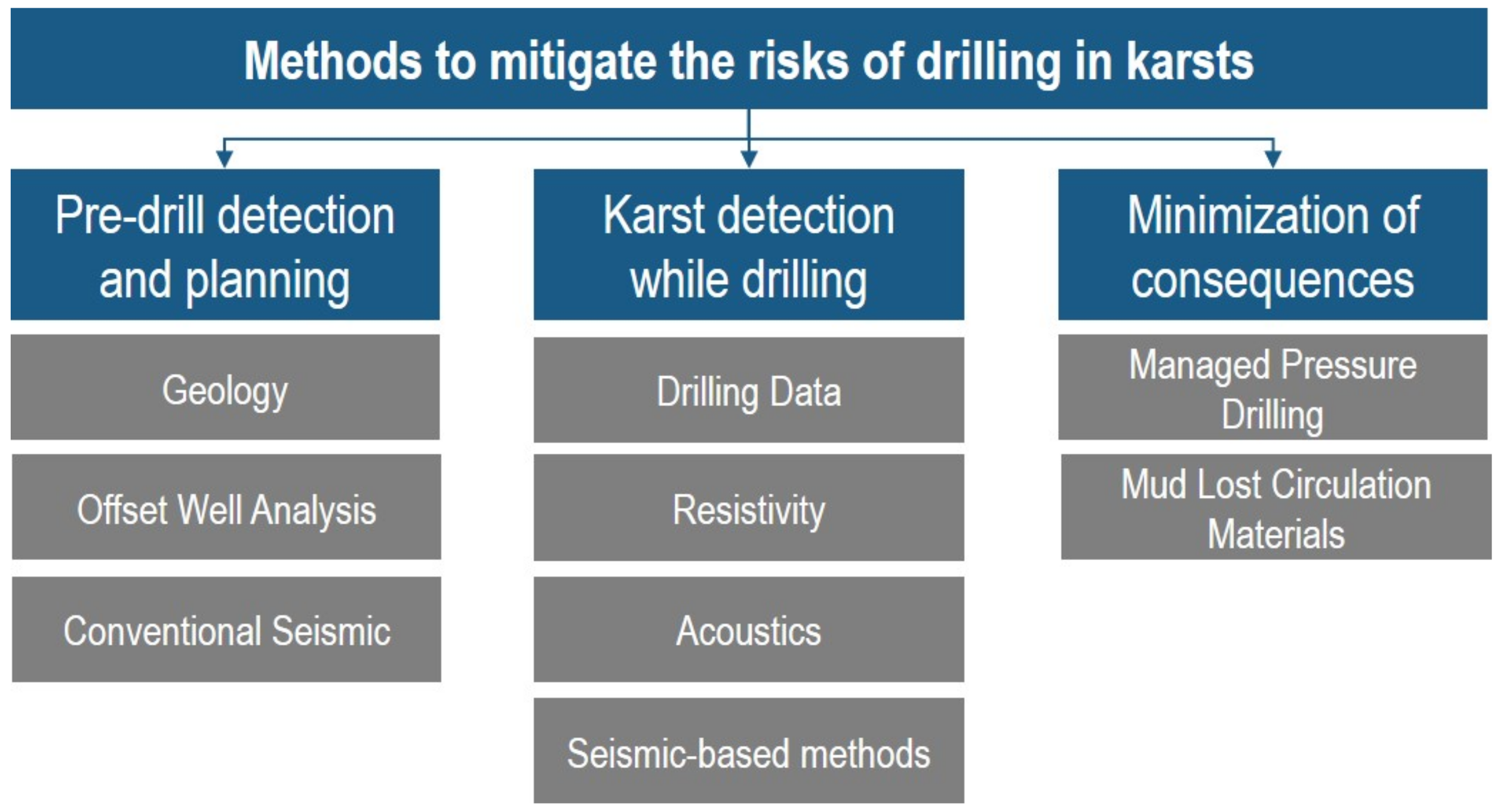
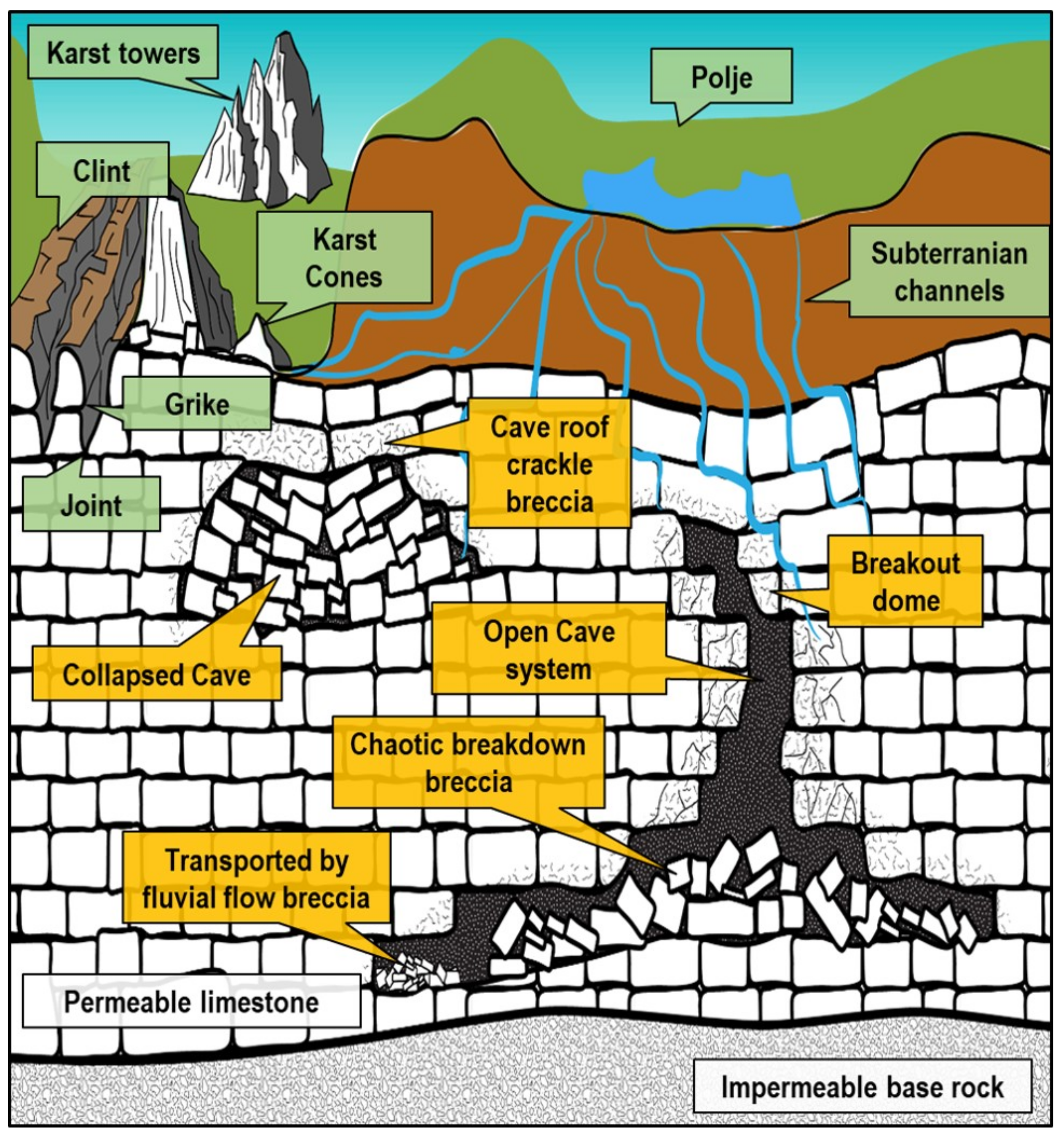
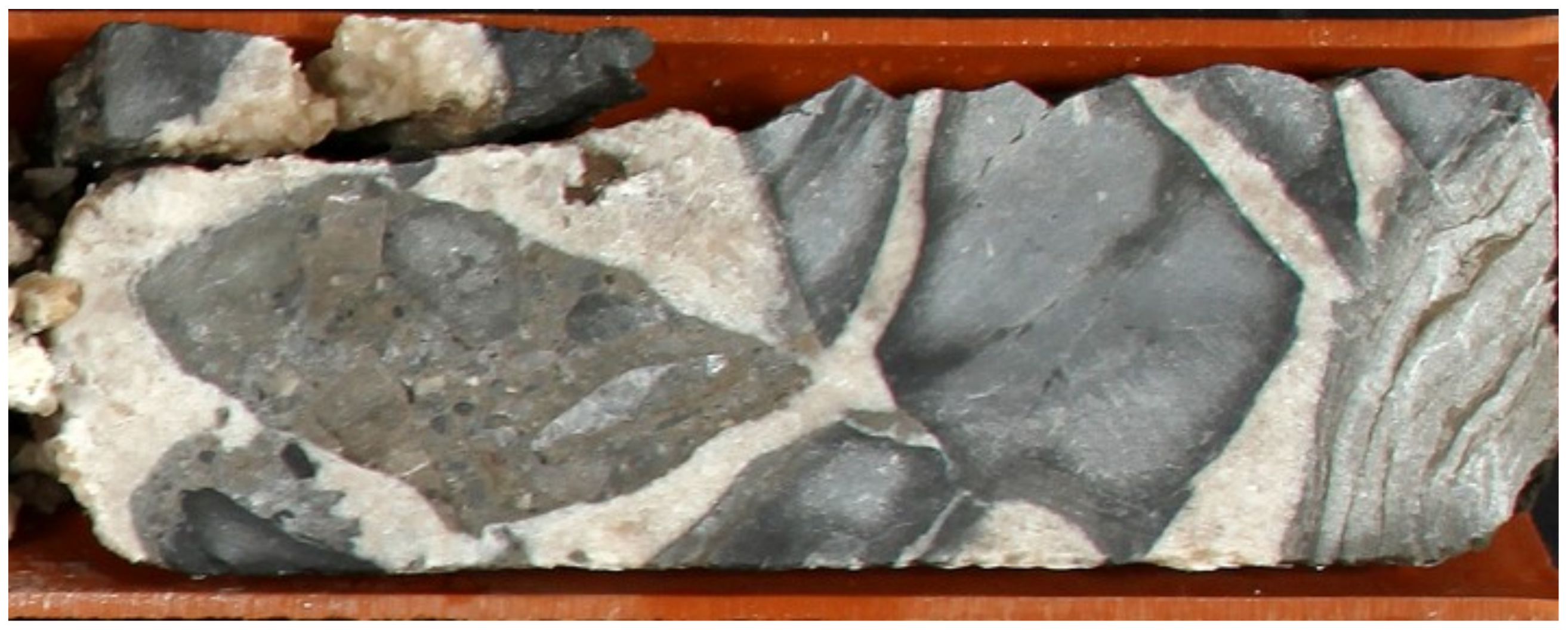
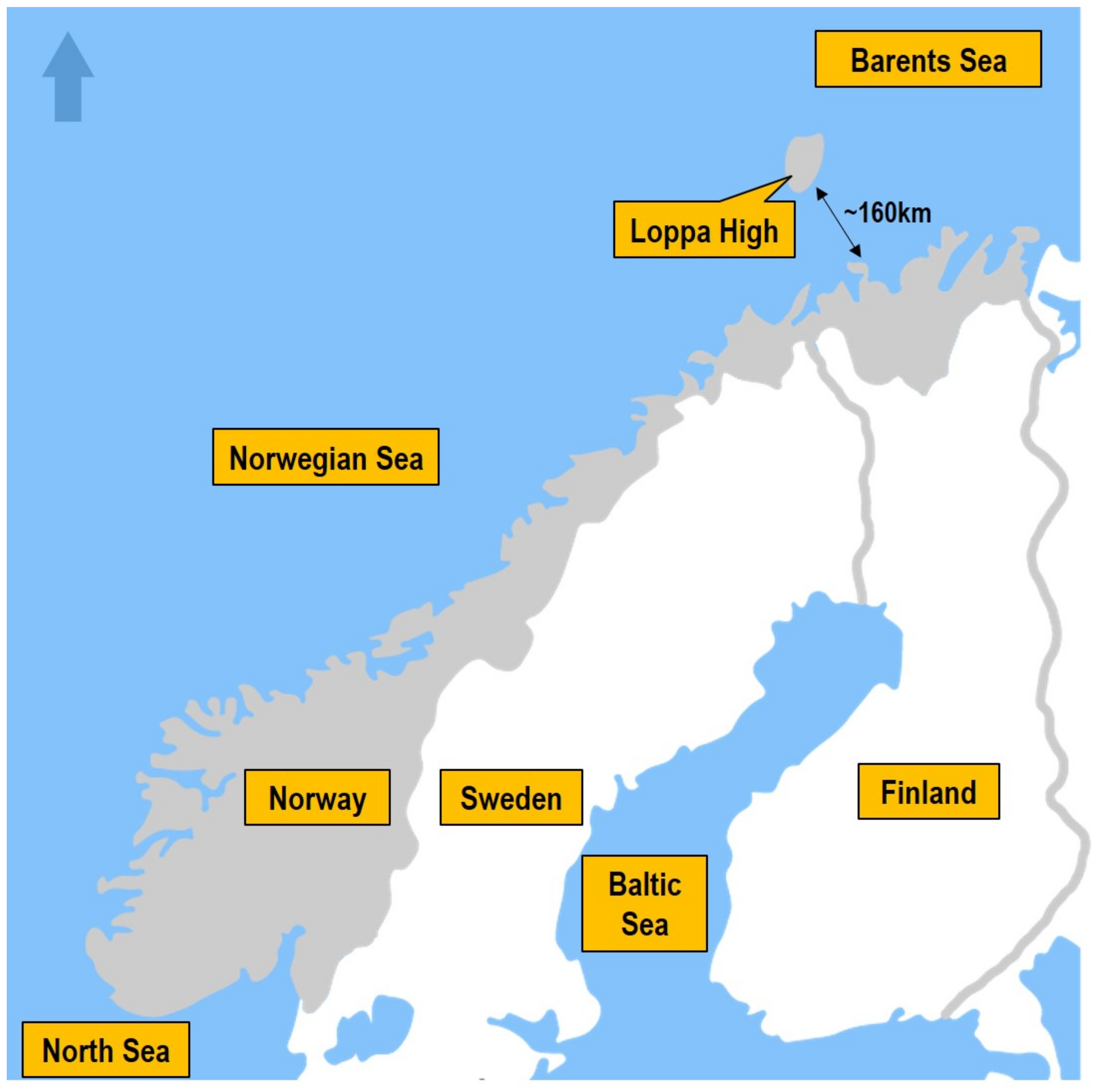
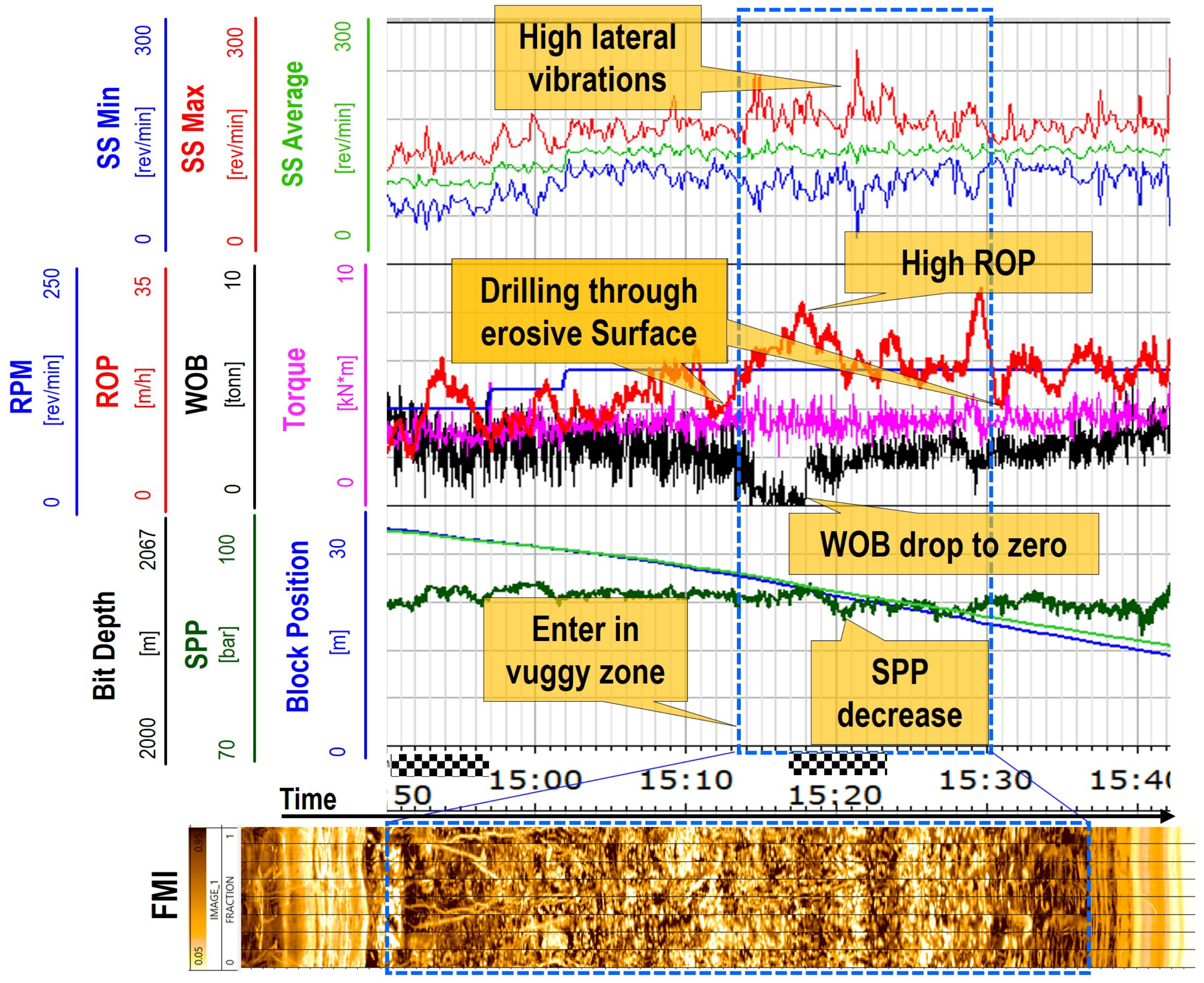
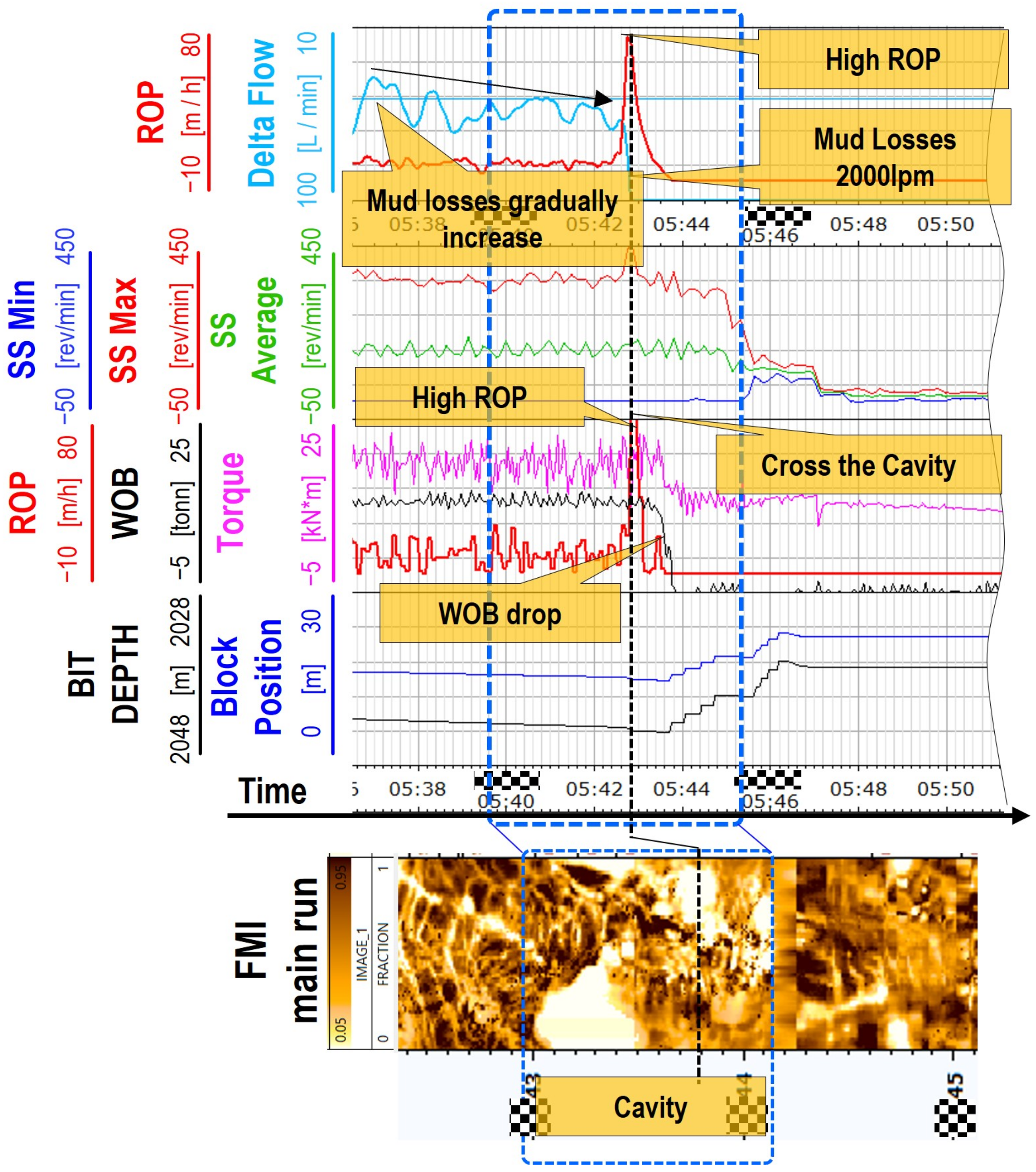
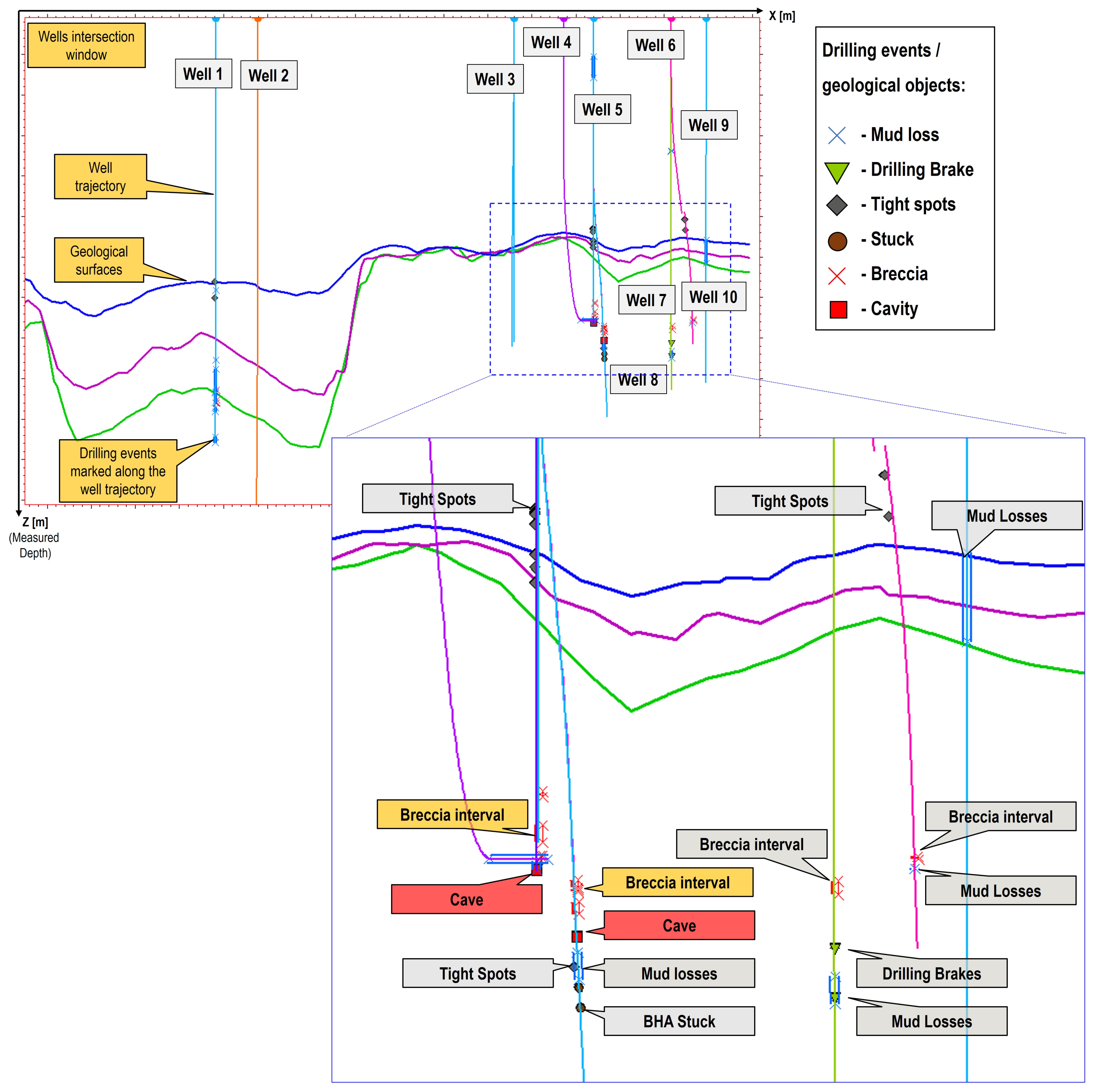
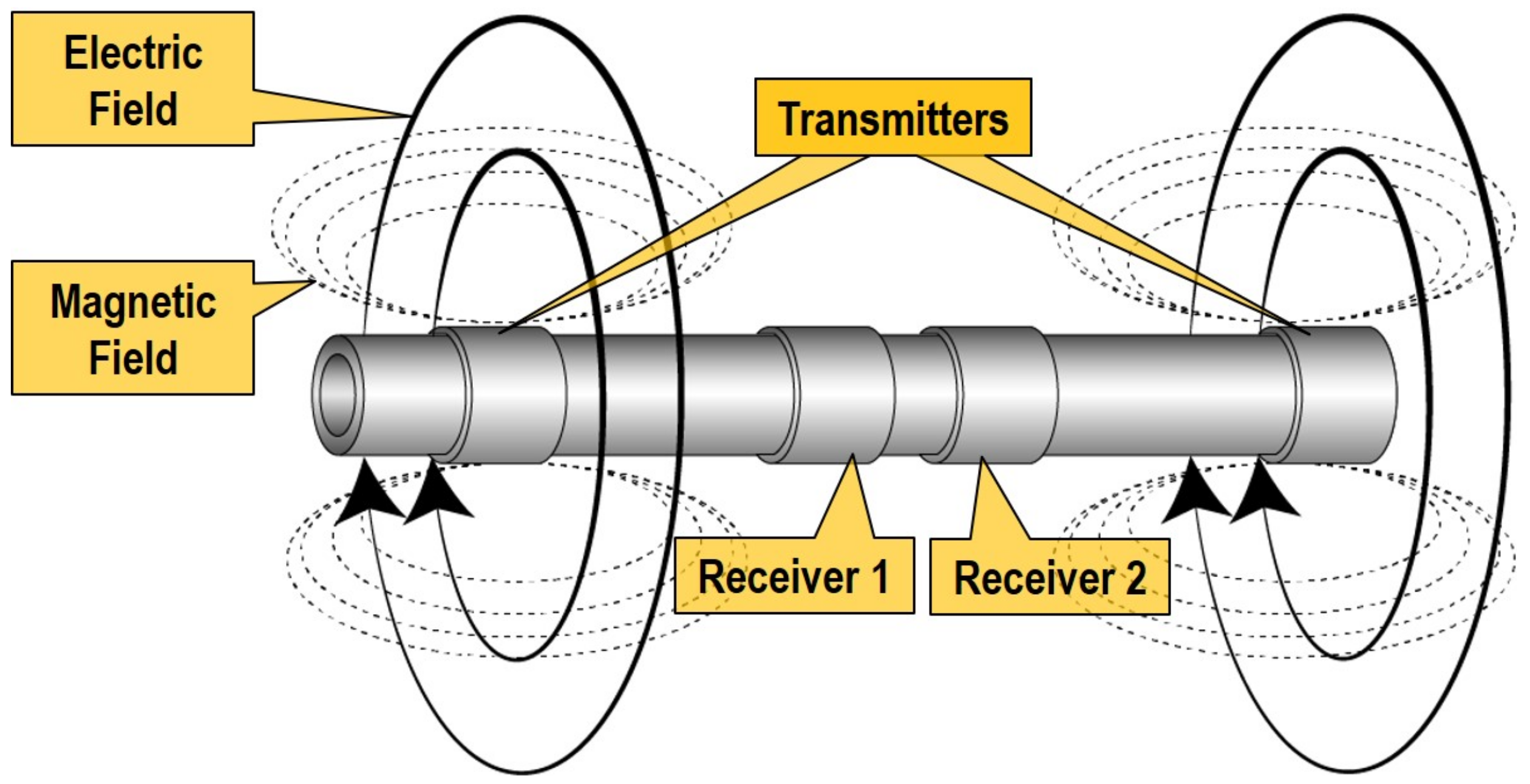
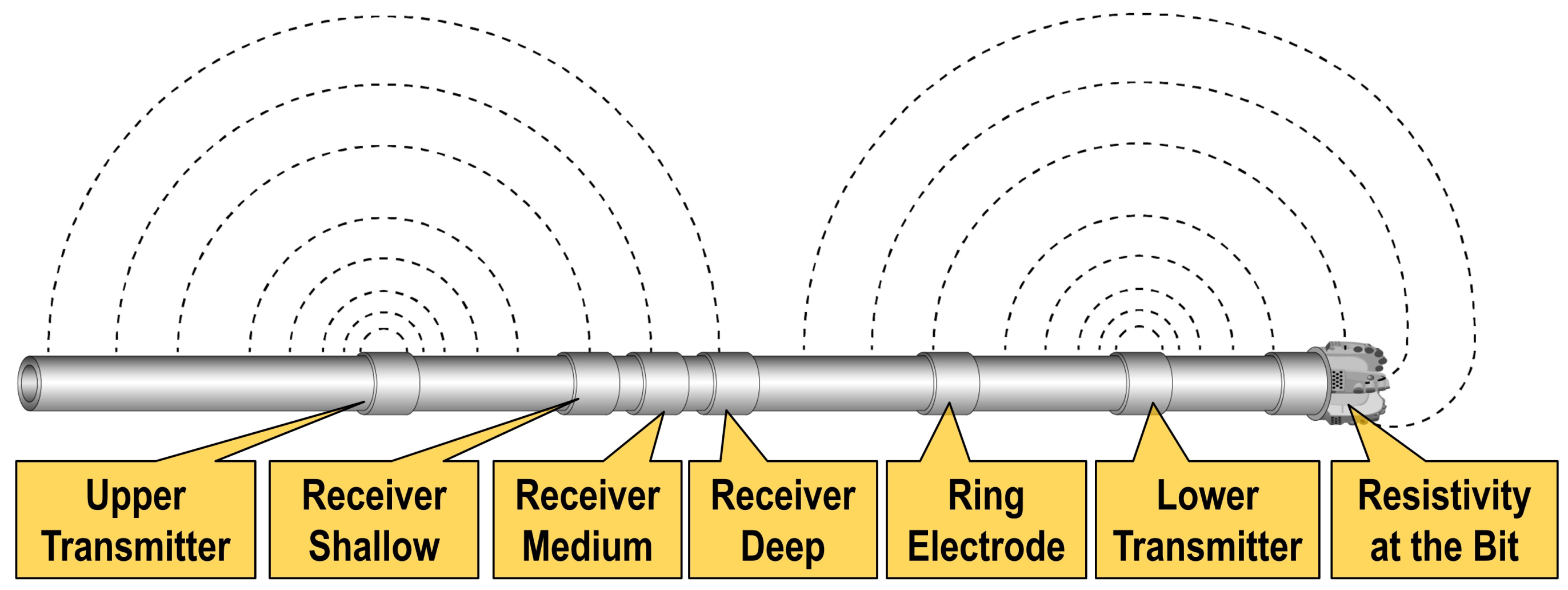
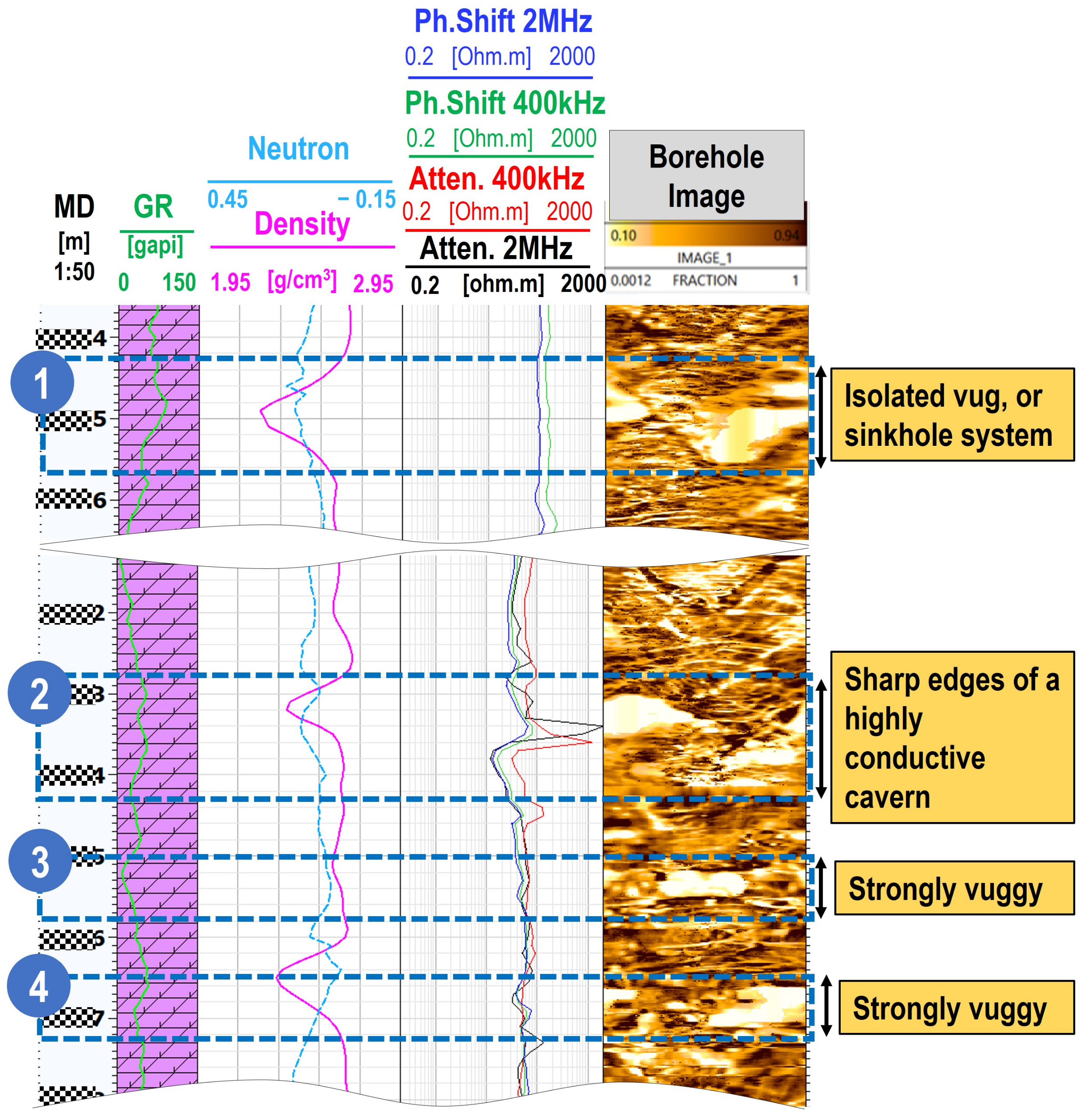
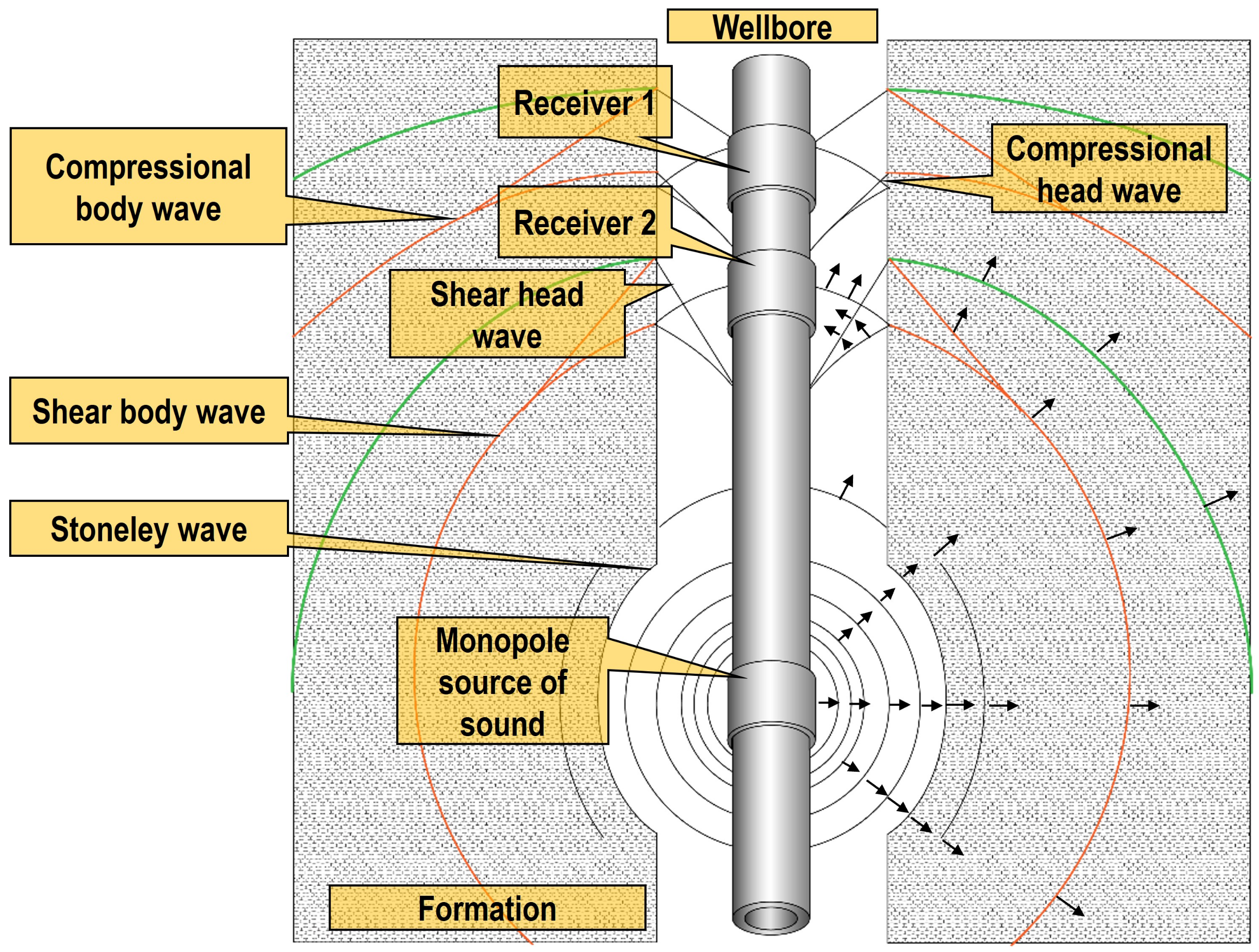
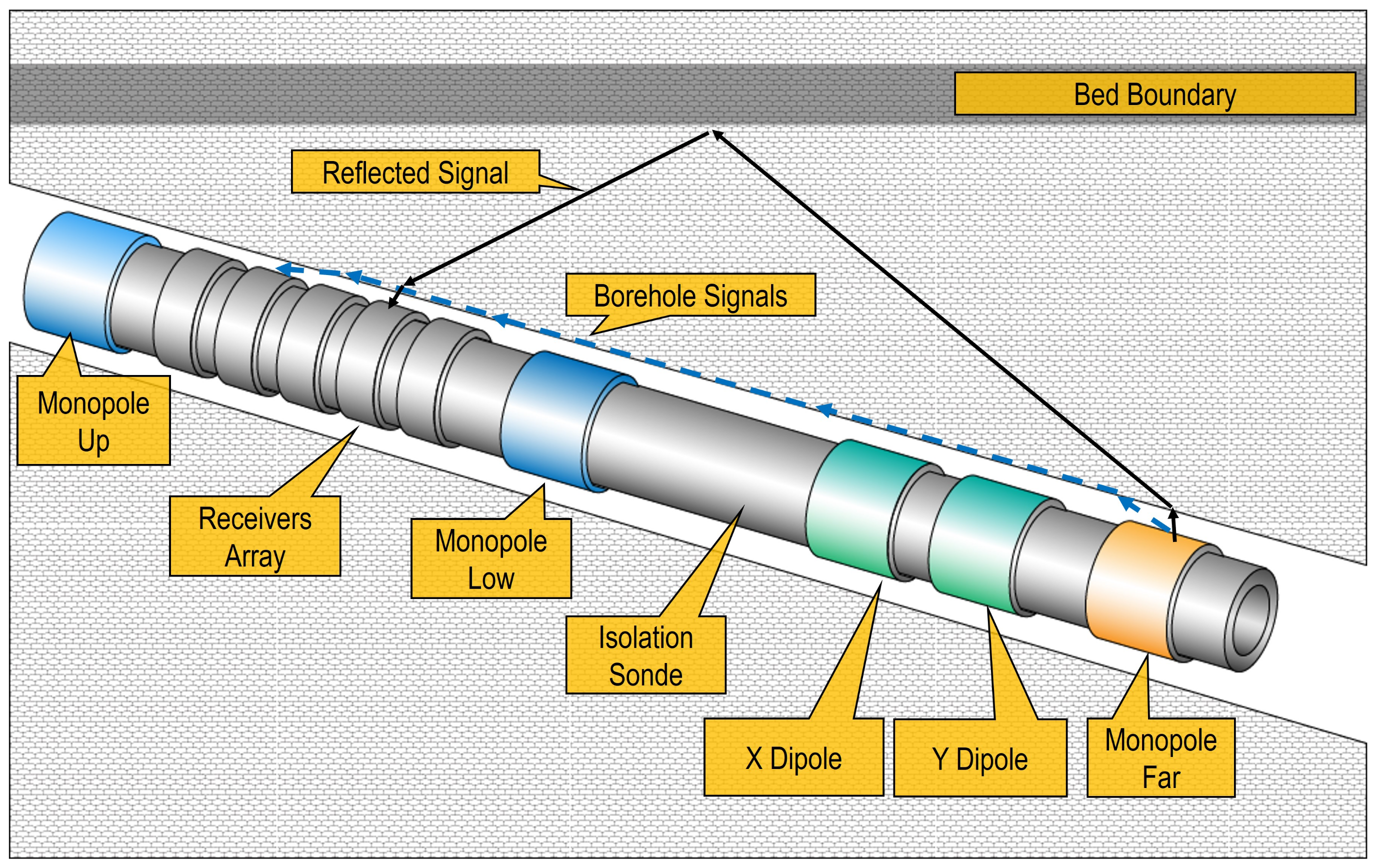
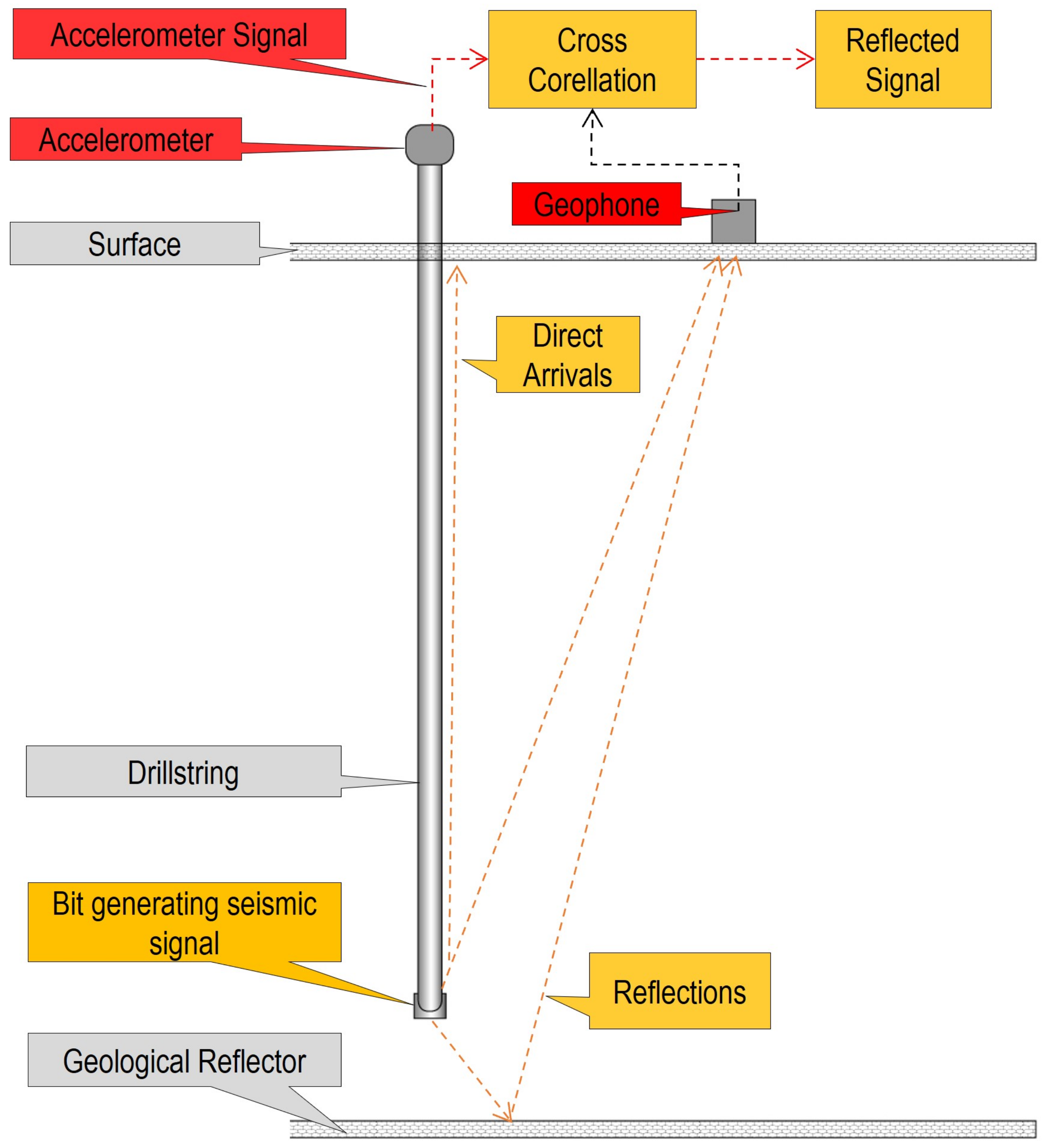

| Measurement | Abbreviation | Unit |
|---|---|---|
| Depth of the bit | Bit depth | [m] |
| Downhole torque | Torque | [kN·m] |
| Difference between inflow and outflow | Delta flow | [L/min] |
| Position of the block | Block position | [m] |
| Revolutions of BHA per minute | RPM | [rev/min] |
| Rate of penetration | ROP | [m/h] |
| Stick/slip of BHA | SS Min/Max/Avg | [rev/min] |
| Stand pipe pressure | SPP | [bar] |
| Weight on bit | WOB | [ton] |
| Method | Look Ahead | Advantages | Limitations | Karst Prediction |
|---|---|---|---|---|
| Geological (Section 2) | N/A | 1. Early detection of surface and subsurface signs of karstification 2. Overall picture of the geological region | Karst detection depends on the coverage and quality of input geophysical data | Yes |
| Offset wells analysis (Section 3.1) | N/A | 1. Gained experience and dangerous intervals for drilling from the offset wells can be transformed to plan a well path 2. Additional sensors/measurements are not required for the analysis | 1. Karst prediction on the planned well depends on whether or not karsts were defined on the offset wells 2. Many objects may be unforeseen in the offset wells due to a lack of geophysical studies or geological heterogeneity 3. Different methods can project dangerous intervals differently | Yes |
| Conventional seismic (Section 3.2) | Yes | 1. Earth subsurface images 2. The most complete picture of the main subsurface objects 3. General karst distribution/spatial positions can be revealed | 1. Inability to identify small karst forms 2. Possible inaccuracy of the exact subsurface objects’ positions identification | Partially |
| Type of Measurements | Abbreviation | Method Name | Look Ahead | ∼DOI | Tested | Advantages | Limitations | Early Karst Detection |
|---|---|---|---|---|---|---|---|---|
| Drilling data | n/a | Drilling mechanics and mud-flow (Section 4.1) | Possible | Up to 20 m | Yes | 1. Signs of karstification can be detected based on already existing real-time drilling data 2. Different karst types can be distinguished 3. Detection can serve for ahead-of-the-bit prediction | 1. Detection accuracy depending on different factors. Not all of them can be taken into account 2. Certain karst forms are challenging to detect (collapsed caves, small vugs, etc.) | Yes |
| Resistivity based | n/a | Ultra-deep resistivity (Section 4.2.1) | No | Up to 70 m | Yes | 1. Significant boundary detection distances 2. Possible to detect karsts with high resistivity contrast boundaries 3. Predictable radiation pattern; less affected by drilling noise. | 1. DOI and accuracy depending on the formations’ and drilling mud electrical properties 2. It is challenging to detect low-contrast geological objects 3. High-bit-sensor offset | No |
| RAB | Resistivity at the bit (Section 4.2.2) | Yes | Up to 0.1 m | Yes | 1. Directed ahead-of-the-bit measurements 2. Measurements while drilling | 1. Shallow depth of investigation 2. Non-azimuthal quantitative measurements 3. Challenging to detect low-contrast geological objects | No | |
| Acoustics | BARS | Borehole acoustic reflected survey (Section 4.3.1) | No | Up to 20 m | Yes | 1. High vertical resolution 2. DOI is almost unaffected by formation properties 3. Deep interface reflections can be separated from the other ones | 1. Look-around measurements 2. Sensitive to downhole noise, preferably should be taken outside of drilling periods | Yes |
| Seismic | n/a | Downhole excitation of seismic waves (Section 4.4.1) | Yes | Up to 2000 m | No | 1. Powerful seismic pulse attempted to be generated downhole 2. Potentially higher resolution than conventional seismic method 3. Low-reflections might be detected | 1. The unpredictable wave radiation pattern 2. Challenging to focus the signal ahead of the drill bit 3. Dangerous for the wellbore walls | No |
| n/a | Directional sound waves generation (Section 4.4.2) | Yes | Up to 100 m | No | 1. Focused acoustic signal ahead of the bit 2. Small bit-sensor offset 3. Controllable frequencies range | 1. Hardware manufacturing challenges 2. Difficulties of signal processing 3. Unwanted reflections from downhole inner/outer-parts | No | |
| SWD | Seismic while drilling (Section 4.5) | Yes | Up to 300–500 m | Yes | 1. Detailed seismic maps of surrounding formations, including measurements ahead of the bit 2. Higher than conventional seismic resolution | 1. Small karsts can be missed due to radiation pattern and detection challenges 2. Not applicable to deviated ERD wells 3. Not applicable to low-energy modern PDC bits | No | |
| SGD | Seismic-guided drilling (Section 4.5.1) | Yes | Up to 30–50 m | Yes | 1. Seismic measurements can be obtained without wireline logging 2. High accuracy of large cave detection | 1. Limited resolution due to seismic wavelength utilization 2. Not applicable for small low-reflected objects | Yes |
Publisher’s Note: MDPI stays neutral with regard to jurisdictional claims in published maps and institutional affiliations. |
© 2021 by the authors. Licensee MDPI, Basel, Switzerland. This article is an open access article distributed under the terms and conditions of the Creative Commons Attribution (CC BY) license (https://creativecommons.org/licenses/by/4.0/).
Share and Cite
Maksimov, D.; Pavlov, A.; Sangesland, S. Prediction and Early Detection of Karsts—An Overview of Methods and Technologies for Safer Drilling in Carbonates. Energies 2021, 14, 6517. https://doi.org/10.3390/en14206517
Maksimov D, Pavlov A, Sangesland S. Prediction and Early Detection of Karsts—An Overview of Methods and Technologies for Safer Drilling in Carbonates. Energies. 2021; 14(20):6517. https://doi.org/10.3390/en14206517
Chicago/Turabian StyleMaksimov, Danil, Alexey Pavlov, and Sigbjørn Sangesland. 2021. "Prediction and Early Detection of Karsts—An Overview of Methods and Technologies for Safer Drilling in Carbonates" Energies 14, no. 20: 6517. https://doi.org/10.3390/en14206517
APA StyleMaksimov, D., Pavlov, A., & Sangesland, S. (2021). Prediction and Early Detection of Karsts—An Overview of Methods and Technologies for Safer Drilling in Carbonates. Energies, 14(20), 6517. https://doi.org/10.3390/en14206517





